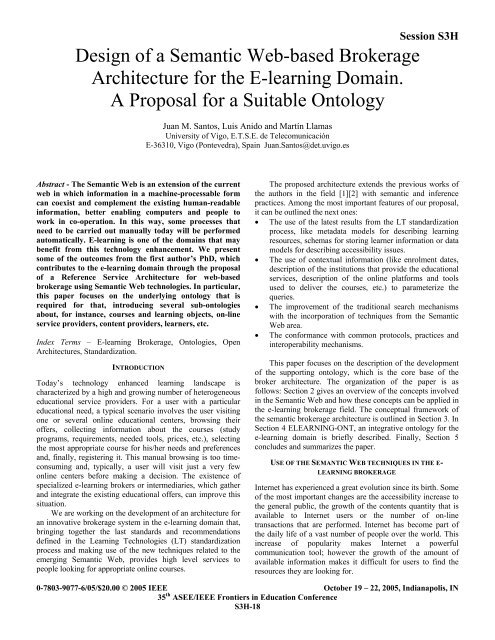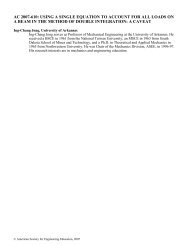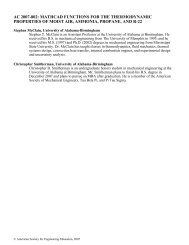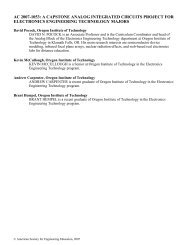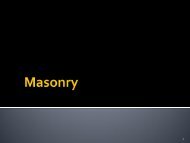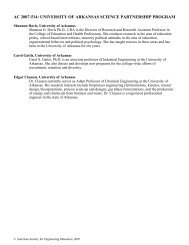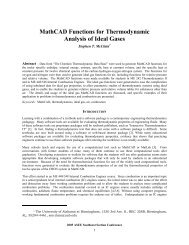Design of a Semantic Web-based Brokerage ... - Icee.usm.edu
Design of a Semantic Web-based Brokerage ... - Icee.usm.edu
Design of a Semantic Web-based Brokerage ... - Icee.usm.edu
You also want an ePaper? Increase the reach of your titles
YUMPU automatically turns print PDFs into web optimized ePapers that Google loves.
<strong>Design</strong> <strong>of</strong> a <strong>Semantic</strong> <strong>Web</strong>-<strong>based</strong> <strong>Brokerage</strong>Architecture for the E-learning Domain.A Proposal for a Suitable OntologyJuan M. Santos, Luis Anido and Martín LlamasUniversity <strong>of</strong> Vigo, E.T.S.E. de TelecomunicaciónE-36310, Vigo (Pontevedra), Spain Juan.Santos@det.uvigo.esSession S3HAbstract - The <strong>Semantic</strong> <strong>Web</strong> is an extension <strong>of</strong> the currentweb in which information in a machine-processable formcan coexist and complement the existing human-readableinformation, better enabling computers and people towork in co-operation. In this way, some processes thatneed to be carried out manually today will be performedautomatically. E-learning is one <strong>of</strong> the domains that maybenefit from this technology enhancement. We presentsome <strong>of</strong> the outcomes from the first author’s PhD, whichcontributes to the e-learning domain through the proposal<strong>of</strong> a Reference Service Architecture for web-<strong>based</strong>brokerage using <strong>Semantic</strong> <strong>Web</strong> technologies. In particular,this paper focuses on the underlying ontology that isrequired for that, introducing several sub-ontologiesabout, for instance, courses and learning objects, on-lineservice providers, content providers, learners, etc.Index Terms – E-learning <strong>Brokerage</strong>, Ontologies, OpenArchitectures, Standardization.INTRODUCTIONToday’s technology enhanced learning landscape ischaracterized by a high and growing number <strong>of</strong> heterogeneous<strong>edu</strong>cational service providers. For a user with a particular<strong>edu</strong>cational need, a typical scenario involves the user visitingone or several online <strong>edu</strong>cational centers, browsing their<strong>of</strong>fers, collecting information about the courses (studyprograms, requirements, needed tools, prices, etc.), selectingthe most appropriate course for his/her needs and preferencesand, finally, registering it. This manual browsing is too timeconsumingand, typically, a user will visit just a very fewonline centers before making a decision. The existence <strong>of</strong>specialized e-learning brokers or intermediaries, which gatherand integrate the existing <strong>edu</strong>cational <strong>of</strong>fers, can improve thissituation.We are working on the development <strong>of</strong> an architecture foran innovative brokerage system in the e-learning domain that,bringing together the last standards and recommendationsdefined in the Learning Technologies (LT) standardizationprocess and making use <strong>of</strong> the new techniques related to theemerging <strong>Semantic</strong> <strong>Web</strong>, provides high level services topeople looking for appropriate online courses.The proposed architecture extends the previous works <strong>of</strong>the authors in the field [1][2] with semantic and inferencepractices. Among the most important features <strong>of</strong> our proposal,it can be outlined the next ones:• The use <strong>of</strong> the latest results from the LT standardizationprocess, like metadata models for describing learningresources, schemas for storing learner information or datamodels for describing accessibility issues.• The use <strong>of</strong> contextual information (like enrolment dates,description <strong>of</strong> the institutions that provide the <strong>edu</strong>cationalservices, description <strong>of</strong> the online platforms and toolsused to deliver the courses, etc.) to parameterize thequeries.• The improvement <strong>of</strong> the traditional search mechanismswith the incorporation <strong>of</strong> techniques from the <strong>Semantic</strong><strong>Web</strong> area.• The conformance with common protocols, practices andinteroperability mechanisms.This paper focuses on the description <strong>of</strong> the development<strong>of</strong> the supporting ontology, which is the core base <strong>of</strong> thebroker architecture. The organization <strong>of</strong> the paper is asfollows: Section 2 gives an overview <strong>of</strong> the concepts involvedin the <strong>Semantic</strong> <strong>Web</strong> and how these concepts can be applied inthe e-learning brokerage field. The conceptual framework <strong>of</strong>the semantic brokerage architecture is outlined in Section 3. InSection 4 ELEARNING-ONT, an integrative ontology for thee-learning domain is briefly described. Finally, Section 5concludes and summarizes the paper.USE OF THE SEMANTIC WEB TECHNIQUES IN THE E-LEARNING BROKERAGEInternet has experienced a great evolution since its birth. Some<strong>of</strong> the most important changes are the accessibility increase tothe general public, the growth <strong>of</strong> the contents quantity that isavailable to Internet users or the number <strong>of</strong> on-linetransactions that are performed. Internet has become part <strong>of</strong>the daily life <strong>of</strong> a vast number <strong>of</strong> people over the world. Thisincrease <strong>of</strong> popularity makes Internet a powerfulcommunication tool; however the growth <strong>of</strong> the amount <strong>of</strong>available information makes it difficult for users to find theresources they are looking for.0-7803-9077-6/05/$20.00 © 2005 IEEE October 19 – 22, 2005, Indianapolis, IN35 th ASEE/IEEE Frontiers in Education ConferenceS3H-18
Due to that problem, some solutions have beenimplemented that try to make it easier browsing Internet.These solutions are search engines and some examples couldbe Google or Yahoo!. It is clear that the <strong>Web</strong> would not havebeen the huge success it was, were it no for search engines.However, there are serious problems related to their use(identified in [3]):• It may happen that a search engine does not get anyanswer for a particular request (this is no frequent, but itis possible, in the most popular search engines) or resultsfrom the query do not include relevant pages (a morefrequent situation).• It <strong>of</strong>ten happens that a lot <strong>of</strong> mildly or lowly relevantresults are returned from a particular request. Even if themain relevant results are retrieved, they could be almostuseless if many others mildly relevant or irrelevantdocuments were also retrieved.• Very commonly the initial keywords queried do not getthe desired results because the relevant documents usedifferent terminology from the original query. This isunsatisfactory because semantically similar queriesshould return similar results. Results are highly sensitiveto vocabulary.• When the needed information is spread over several webresources, it is necessary to do several queries to gatherall the relevant documents, and then the partialinformation must be manually extracted and aggregated.The main obstacle to providing better support to <strong>Web</strong>users is that, at present, the meaning <strong>of</strong> <strong>Web</strong> content is notmachine-accessible. Although keyword-<strong>based</strong> techniques havehad an outright success, results from these engines can beimproved by conveniently describing the resources in thesearch space in a machine-readable way.The coming <strong>Semantic</strong> <strong>Web</strong> [4] is an extension <strong>of</strong> thecurrent web in which information in a machine-processableform can coexist and complement the existing human-readableinformation, better enabling computers and people to work incooperation.For the <strong>Semantic</strong> <strong>Web</strong> to function, facilities to putmachine-understandable data on the web must be developed.Ontologies [5] figure prominently in the emerging <strong>Semantic</strong><strong>Web</strong> as a way <strong>of</strong> representing the semantics <strong>of</strong> documents andenabling that semantics to be used by web applications andintelligent s<strong>of</strong>tware agents. An ontology defines the termsused to describe and represent an area <strong>of</strong> knowledge (likemedicine, tool manufacturing, automobile repair, financialmanagement, etc.), including computer-usable definitions <strong>of</strong>basic concepts in the domain and the relationship among them.They encode knowledge in a domain and also knowledge thatspans domains. In this way, they make that knowledgereusable.In order for ontologies to fulfil their role in the semanticintegration <strong>of</strong> the <strong>Web</strong>, there will need to be somestandardization <strong>of</strong> <strong>Web</strong> ontology languages. The W3C isalready moving in this direction with languages such as RDF(Resource Description Framework) and RDFS (ResourceSession S3HDescription Framework Schema). However, in order toachieve the widest possible acceptability, these languageshave deliberately been kept very simple and have relativelyweak semantics. Much richer ontology specification languagesare needed in order support the design, sharing and integration<strong>of</strong> the complex ontologies. Although during the last yearsvarious languages for the definition <strong>of</strong> ontologies have beenproposed [6], on February 2004 the W3C has standardizedOWL [7] as the language for the semantic description <strong>of</strong> <strong>Web</strong>resources.For the construction <strong>of</strong> a semantic LT Broker, we needthe definition <strong>of</strong> a specific ontology that includes all therelevant terms required to describe all the involved entities(courses, providers, clients, e-learning platforms, etc.).ELEARNING-ONT, an OWL integrative ontology will bedescribed in Section 3. Data collected from EducationalServices Providers and supplied by Clients will beconveniently transformed by the Broker into OWL statementsthat make use <strong>of</strong> the terms identified in ELEARNING-ONT.This transformation process, as well as other d<strong>edu</strong>ctive tasks(e.g. triggering <strong>of</strong> notification messages), is supported byinference rules, it is, axioms that specify an action if certainconditions are met. Currently, several rule languages coexist,but, for our prototypes, we use Notation 3 –or N3– [8] because<strong>of</strong> its simplicity: N3 is a simplified ontology language withsupport for rules and queries.Information stored in the Broker, as OWL statements, canbe queried through a semantic search engine. <strong>Semantic</strong> <strong>Web</strong>query languages, like RDQL [9], can be used to formulatecomplex queries in order to retrieve exactly the information inwhich we are interested. Subsequently a RDQL query isshown that would permit to locate the “courses” <strong>of</strong> “mediumdifficulty” on “literature” that are written in “Castilian”.SELECT ?a,WHERE (?a, , learn-ont:Course),(?a, ,lom-<strong>edu</strong>:MediumDifficulty),(?a, , “LITERATURE”,(?a, ,learn-ont-idiom:Castilian)It must be noted that courses declared to be written in“Spanish” will be also returned, because ELEARNING-ONTdefines that “learn-ont-idiom:Spanish” and “learn-ontidiom:Castilian”are equivalent.THE FRAMEWORKIn the LT brokerage context, Brokers collect the descriptions<strong>of</strong> the courses from the academic institutions, as well as thereferring contextual information in which they are delivered(data about the institution, delivering tools, dates forenrolment/delivery, etc.). These institutions or EducationalServices Providers (ESPs) should be registered in a Brokerand provide, among other data, the pr<strong>of</strong>ile <strong>of</strong> the institutionand the mechanism for accessing the catalogues <strong>of</strong> theproducts they <strong>of</strong>fer. The customers <strong>of</strong> a Broker can access tothe different services <strong>of</strong>fered by the intermediation system0-7803-9077-6/05/$20.00 © 2005 IEEE October 19 – 22, 2005, Indianapolis, IN35 th ASEE/IEEE Frontiers in Education ConferenceS3H-19
making use <strong>of</strong> different devices, such as personal or portablecomputers, pocket computers or advanced mobile telephones.Figure 1 shows the functional elements <strong>of</strong> a scalable andadaptable <strong>Semantic</strong> E-learning <strong>Brokerage</strong> architecture. Itmakes use <strong>of</strong> particular ontologies (described in Section 3) andinference rules that can be refined without structural changesin the infrastructure as new statements are identified. Next, themost important elements in the architecture are brieflydescribed (for a deeper description see [10]):• Knowledge Base: This is the basic and core element <strong>of</strong>the intermediation system. Here, it is available all theinformation collected and inferred by the Broker, bothfrom the ESP and from the different types <strong>of</strong> Clients. It isa repository where Ontologies, Inference Rules,Educational Resources and Course Descriptions, ServiceProvider Pr<strong>of</strong>iles, User Pr<strong>of</strong>iles and E-learning PlatformDescriptions are stored.• Search Engine. It is the s<strong>of</strong>tware component thatprovides an API with methods for querying theKnowledge Base. Although there are many ontologyquery languages, currently RDQL [9] is the most us<strong>edu</strong>ntil a recommended language will be issued by the W3C.• Inference Engine. This component is responsible forinferring new facts (new OWL statements) from a set <strong>of</strong>previous OWL facts taking into account additionalinformation defined by a particular ontology and in a set<strong>of</strong> inference rules (or axioms).• Data Collector. It is the component that gathersinformation from the registered ESPs automatically.FIGURE 1CONCEPTUAL BROKERAGE ARCHITECTURESession S3H• Services. Different services are <strong>of</strong>fered by the describedinfrastructure. Some <strong>of</strong> them are Anonymous Searches,Personalized Searches, Notification Service, CourseAnnotation, Relevance Estimation Service, TaxonomyManagement and Supporting Services.• Access Interfaces. Different interfaces are provided tothe clients in order to support different access devices(PCs, PALMs, Pocket PCs, WAP devices, etc.).Administrators <strong>of</strong> academic institutions are provided withparticular access interfaces to register and modify theirdata. Likewise, in Figure 1 it is shown an access entrypoint for s<strong>of</strong>tware agents. This Agent Interface consists <strong>of</strong>a set <strong>of</strong> <strong>Web</strong> Services [11] that conforms to a standardizedaccess model [12].THE ONTOLOGYSeveral organizations and institutions (e.g. IMS, ADL, AICC,IEEE’s LTSC, CEN/ISSS/LT, ARIADNE, etc.) have beenworking towards the development <strong>of</strong> standards andrecommendations aimed at solving the interoperabilityproblems currently found in the e-learning domain [13]. Theresult <strong>of</strong> this effort is a basic set <strong>of</strong> information models thatallow the representation <strong>of</strong> several entities involved in the e-learning area. Several <strong>of</strong> these standards, like the metadatamodels for describing learning resources, formats for definingcompetencies, schemas for represent learner information, datamodels for describing accessibility issues, are the basis for thedefinition <strong>of</strong> ELEARNING-ONT, a set <strong>of</strong> interconnectedOWL ontologies that facilitate the automatic management <strong>of</strong>the implicit semantic present in the instances <strong>of</strong> thestandardized data models.ELEARNING-ONT, which is briefly depicted in thisSection, includes the definition <strong>of</strong> the concepts, and their interrelations,necessary to develop brokerage services in the e-learning domain. Due to the great quantity <strong>of</strong> identified terms,the ontology is organized in a range <strong>of</strong> namespaces (or subontologies).There exists a basic namespace, wherefundamental concepts such as “Educational Resource”,“Course” or “Educational Services Provider” are defined. Aseries <strong>of</strong> sub-ontologies include the properties, with theircorresponding vocabularies, that can be used to describe indetail the instances <strong>of</strong> the most basic classes.MethodologyIn order to identify the most suitable terms to be included in adraft proposal <strong>of</strong> a domain OWL Ontology for <strong>edu</strong>cationalbrokerage, we defined a systematic methodology. Thismethodology is <strong>based</strong> on the guidelines proposed by Noy andMcGuinness in [14] and the recommendations described in theUnified S<strong>of</strong>tware Development Process [15].The first stage <strong>of</strong> the development process involves thecapture and documentation <strong>of</strong> the most basic functionalrequirements from clients' viewpoint. Starting from a set <strong>of</strong>core requirements, we successively redefine the “Search forCourse in Broker” use case (c.f. Figure 2) in order to capturenew and different query possibilities. For each stage we applythe steps proposed by Noy and McGuinness:0-7803-9077-6/05/$20.00 © 2005 IEEE October 19 – 22, 2005, Indianapolis, IN35 th ASEE/IEEE Frontiers in Education ConferenceS3H-20
SearcherSearch for Course in BrokerAnonymous SearchGet Course DescriptionGet Course ServicesFIGURE 2CORE USE CASESCustomized SearchRefine Search• Identification <strong>of</strong> the aim and the scope <strong>of</strong> the ontology.• Consider to reuse existing vocabularies (in our case, wemake use <strong>of</strong> the elements defined on the data modelsidentified by the LT standardization process).• Enumerating the most important terms in the ontology.• Defining the classes and their hierarchy.• Defining the properties <strong>of</strong> the classes.• Defining the features <strong>of</strong> the properties.• Creating instances.In this way, the development <strong>of</strong> the ontology is aniterative process, centred on the architecture and driven by usecases, where each stage refines the previous one. As the usecases mature and are refined and specified in more detail,more <strong>of</strong> the ontology terms are discovered. This, in turn, canlead to new use cases. Therefore, both the ontology and theuse cases mature together.Users OntologyThis sub-ontology includes the properties and classes directlyrelated to the characterization <strong>of</strong> the users <strong>of</strong> the brokeragesystem. The terms identified in this namespace have beenmainly extracted from the data models Learning InformationPackage [16] and Accessibility [17], both developed by theIMS Consortium. The first <strong>of</strong> these standardized modelsidentifies the necessary elements to describe the characteristics<strong>of</strong> a (potential) student, whereas the second one extends theprevious model with elements that allow us to specify certainuser preferences. The existence <strong>of</strong> the user’s ontology inELEARNING-ONT makes it possible to the intermediationsystem the accomplishment <strong>of</strong> searches adapted to the userSession S3Hneeds and preferences in order to obtain more relevant resultsfor the client.Courses and Educational Resources OntologyMetadata is one <strong>of</strong> the most prolific fields in the LTstandardisation process. Almost all the institutions andorganizations involved in this process have made their ownproposals in this field. Currently, the Learning ObjectMetadata [18] model, developed jointly by several <strong>of</strong> theinstitutions involved in this process, is already an <strong>of</strong>ficialstandard <strong>of</strong> the IEEE. This standard, and in particular its RDFbinding, developed by Nilsson et al. [19], has been used as thebasis for the sub-ontology <strong>of</strong> ELEARNING-ONT that includesthe needed classes and properties to characterize academiccourses.This ontology is composed <strong>of</strong> 10 namespaces that groupclasses and properties related to a particular feature <strong>of</strong> thecourses: lom-base (which includes general classes used in theother namespaces), lom-general (with properties that allowspecifying the aggregation level and the type <strong>of</strong> structure <strong>of</strong>the <strong>edu</strong>cational resources), lom-lifecycle (with classes andproperties for the description <strong>of</strong> the resource life cycle), lommetametadata(that contains classes and properties to describethe metadata scheme used), lom-technical (which referencesthe technical requirements for the execution <strong>of</strong> the <strong>edu</strong>cationalresource), lom-<strong>edu</strong>cational (this is the most importantnamespace. It defines classes and properties which describepedagogical aspects <strong>of</strong> the resources), lom-rights (referringbasically to the costs and legal restrictions <strong>of</strong> the <strong>edu</strong>cationalresource), lom-relation (it contains a only property,isBasisFor), lom-annotation (that will be used add commentabout courses) and finally lom-classification (whose maintarget is to show the classification system in which theresource can be categorized).Educational Services Providers OntologyThis sub-ontology gathers some terms that allow makingdescriptions about <strong>edu</strong>cational services providers. These areentities or organizations that deliver courses on-linethroughout a particular e-learning platform. Due to the lack <strong>of</strong>standardized conceptual models in the e-learning domainrelated to this topic, we have taken from the e-commercedomain common use schemes that allow describingenterprises. Particularly, our sub-ontology is <strong>based</strong> on theEnterprise Ontology [20], developed by the ArtificialIntelligence Applications Institute from the University <strong>of</strong>Edinburgh.Educational Platforms OntologyOn-line courses are <strong>of</strong>fered to students throughout e-learningplatforms. We assume that an e-learning platform is a <strong>Web</strong>application that includes Internet tools and services within anenclosed space specifically configured and organized toprovide learning in a convenient and satisfactory way.0-7803-9077-6/05/$20.00 © 2005 IEEE October 19 – 22, 2005, Indianapolis, IN35 th ASEE/IEEE Frontiers in Education ConferenceS3H-21
Session S3Hlip :QCLlip:Activitylip:Preferencelip : Goallip : qcllip:activity lip:preferencelip : goallip:Interestlip:interestPersonlip:competencylip :identificationCompetencylip : Identificationrdfs: subClassOfrdfs:subClassOflip : Namelom-<strong>edu</strong>:LearingResourceTypelom- <strong>edu</strong>: InterativityTyperdfs:subClassOfadquireslom-<strong>edu</strong>: InterativityLevelLearnerlom-<strong>edu</strong>:learningResourceTypecoveredBylip :Addresslom-<strong>edu</strong>:interativityTypelom-<strong>edu</strong>: ContextinteractsWithlom-<strong>edu</strong>:interativityLevellom-<strong>edu</strong>:contextlom-<strong>edu</strong>: AgeRangelom-<strong>edu</strong>:ageRangeCourserdfs:subClassOfLearningResourcelom-<strong>edu</strong>:dificultylom- <strong>edu</strong>:Dificultylom-<strong>edu</strong>:languagehasSch<strong>edu</strong>lingprovideslom-gen:structurelom- <strong>edu</strong>: LanguageCalendarimpartedWithEducationalServiceProviderlom-gen:aggregationLevellom-life:statuslom-gen: StructureTypeuseslom- gen :AggregationLevelEducationalPlatformlom-life: StatusTypeFIGURE 3SOME CLASSES AND PROPERTIES IDENTIFIED IN ELEARNING-ONTMany <strong>edu</strong>cational platform surveys have been used toelaborate the sub-ontology that allows the characterization <strong>of</strong>these applications and the terms considered to be moreconvenient have been taken from them. The experience <strong>of</strong> theauthors related to the construction <strong>of</strong> e-learning platforms hasbeen essential in this field. Mostly, the terms in this subontologyallow defining the available tools in a platform.Other Ontologies and TaxonomiesBesides the mentioned sub-ontologies, some othervocabularies and taxonomies have been used. Among them,we can mention a subset <strong>of</strong> the Universal DecimalClassification [21] scheme, to use it as a vocabulary <strong>of</strong> several<strong>of</strong> the properties defined in ELEARNIG-ONT. The DAML-Time [22] ontology has also been imported to representtemporal concepts (for example, course calendars). Severalother data models are currently under study, like ontologiesthat let us to describe user’s devices.SUMMARY AND FUTURE WORKSThe <strong>Semantic</strong> <strong>Web</strong> is not a separate <strong>Web</strong> but an extension <strong>of</strong>the current one, in which information is given well-definedmeaning, better enabling computers and people to work incooperation. In this paper, we have outlined the basic issues <strong>of</strong>an intermediation system in the e-learning domain that makesuse <strong>of</strong> the <strong>Semantic</strong> <strong>Web</strong> techniques in order to improve thesearching and location processes. This Broker can performqueries in its knowledge base taking into account the userpr<strong>of</strong>ile, i.e. the needs <strong>of</strong> the user and its preferences regardingtime availability, difficulty level, obtained degree, etc.This paper have briefly introduced the underlyingontology that is required for that, introducing several subontologiesabout, for instance, courses and learning objects,on-line service providers, content providers, learners, etc. Thisontology, named ELEARNING-ONT (c.f. Figure 3), providesthe needed semantics to let computers automatically deal withadaptive intermediation in the e-learning domain.Some work is taking place and will be developed in thefuture: Finalization <strong>of</strong> the prototypes <strong>of</strong> the architecture0-7803-9077-6/05/$20.00 © 2005 IEEE October 19 – 22, 2005, Indianapolis, IN35 th ASEE/IEEE Frontiers in Education ConferenceS3H-22
presented, final specification and validation <strong>of</strong> the supportontologies and the countersign <strong>of</strong> the proposal in someforums.ACKNOWLEDGMENTWe want to thank “Ministerio de Educación y Ciencia” for itspartial support to this work under grant “MetaLearn:methodologies, architectures and languages for E-learningadaptive services” (TIN2004-08367-C02-01). We also want tothank the European Commission, Directorate-General forEducation and Culture (DG EAC) for its support through theLearning Interoperability Frameworks for Europe (LIFE)project.REFERENCES[1] Anido L., Rodríguez J., Caeiro M., Santos J.M. “High-level brokerageservices for the e-learning domain”. Computer Standards & Interfaces,Volume 25, Issue 4, 2003, pp. 303-327.[2] Anido L., Fernández M.J., Caeiro M., Santos J.M., Rodríguez J., LlamasM. “Educational Metadata and <strong>Brokerage</strong> for Learning Resources”,Computers and Education, Num. 32, 2002, pp. 351-374.[3] Antoniou G, van Harmelen F. “<strong>Semantic</strong> <strong>Web</strong> Primer”. The MIT Press,2004.[4] Berners-Lee T., Hendler J., Lassila O. “The <strong>Semantic</strong> <strong>Web</strong>”. ScientificAmerican, May issue, 2001.[5] Chandrasekaran B., Josephson J.R., Benjamins V.R. “What AreOntologies and Why Do We Need Them”. IEEE Intelligent Systems, 14,1999, pp. 20-26.[6] Bechh<strong>of</strong>er S. “Ontology Language Standardisation Efforts”. Onto<strong>Web</strong>Technical Report, 2002.[7] McGuinness D.L., van Harmelen F. “OWL <strong>Web</strong> Ontology LanguageOverview”. W3C Recommendation, 10 February 2004.[8] Berners-Lee T., Connolly D., Hawke S. “Primer: Getting into RDF &<strong>Semantic</strong> <strong>Web</strong> using N3”. Tutorial at the Twelfth International WorldWide <strong>Web</strong> Conference, 20-24 May 2003, Budapest, Hungary.Session S3H[9] Seaborne A. “RDQL - A Query Language for RDF”, W3C MemberSubmission, 9 January 2004.[10] Santos J.M., Anido L., Llamas M. “<strong>Semantic</strong> <strong>Brokerage</strong> in StandardsdrivenE-Learning”, Proceedings <strong>of</strong> the 8th IFIP World Conference onComputers in Education, Cape Town, South Africa, 4 – 7 July 2005[accepted for publication][11] Booth D., Haas H., McCabe F., Newcomer E., Champion M., Ferris C.,Orchard D. “<strong>Web</strong> Services Architecture”. W3C Working Group Note,11 February 2004.[12] Riley K., McKell M. “IMS Digital Repositories Interoperability - CoreFunctions Information Model” IMS Technical Report, 2003.[13] Santos J., Caeiro M., Rodriguez J., Anido L. “Standardisation in telElearning:a critical analysis” TelE-LEARNING. The Challenge for theThird Millenium, 2003, pp. 321-328[14] Noy N.F., McGuinness D.L. “Ontology Development 101: A Guide toCreating Your First Ontology”, Standford-Protégé Project Report, 2000[15] Jacobson I., Booch G., Rumbaugh J. The Unified S<strong>of</strong>tware DevelopmentProcess, Addison-Wesley, 1999.[16] Norton M., Treviranus J. “IMS Learner Information PackageInformation Model Specification”, IMS Technical Report, 2001.[17] Norton M., Treviranus J. “IMS Learner Information PackageAccessibility for LIP Information Model” IMS Technical Report, 2003.[18] Hodgins W., Duval E. “Learning Object Metadata Standard” IEEE1484.12.1-2002, 2002.[19] Nilsson M., Palmér M., Brase J. “The LOM RDF binding: principles andimplementation”, Proc. <strong>of</strong> the 3rd Annual ARIADNE Conference,Leuven, Belgium, 20-21 November 2003.[20] Uschold M., King M., Moralee S., Zorgios Y. “The EnterpriseOntology”, The Knowledge Engineering Review, Vol. 13, Special Issueon Putting Ontologies to Use, 1998.[21] McIlwaine I.C. “The Universal Decimal Classification: guide to its use”,UDC Publication, no P035, 2000[22] Hobbs J. “A DAML Ontology <strong>of</strong> Time”. DAML Technical Report, 2004.0-7803-9077-6/05/$20.00 © 2005 IEEE October 19 – 22, 2005, Indianapolis, IN35 th ASEE/IEEE Frontiers in Education ConferenceS3H-23


